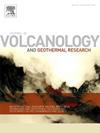Volcanic history of Gölcük caldera (Isparta, Türkiye) with evidence for a Holocene explosive eruption
IF 2.3
3区 地球科学
Q2 GEOSCIENCES, MULTIDISCIPLINARY
Journal of Volcanology and Geothermal Research
Pub Date : 2025-06-30
DOI:10.1016/j.jvolgeores.2025.108403
引用次数: 0
Abstract
Modern Lake Gölcük near the city of Isparta partially fills a caldera that is the focal point of protracted alkaline, potassic–ultrapotassic volcanism in southwestern Anatolia. Because of Gölcük's proximity to a major regional urban center, and field indications for far-reaching pyroclastic density currents (PDC) erupted from this caldera, improved constraints on eruptive recurrence and timing are required. Through field work and combined U![]() Th and (U
Th and (U![]() Th)/He zircon geochronology, the duration of known volcanism at Gölcük has been extended, both to older and, importantly, to younger ages than previously reported. Early activity in the Late Miocene–Pliocene (Stage 1, 6.0–4.2 Ma) was mostly effusive, whereas explosive activity started in the Early Pleistocene (Stage 2, 2.2–1.8 Ma) forming nine PDCs of the Serençay valley ignimbrite sequence. Following a hiatus, PDC and fallout emplacement resumed during Stage 3 (520–480 ka) and Stage 4 (150 ka), with the modern caldera likely being the result of the Stage 4 Çay ignimbrite eruption. U
Th)/He zircon geochronology, the duration of known volcanism at Gölcük has been extended, both to older and, importantly, to younger ages than previously reported. Early activity in the Late Miocene–Pliocene (Stage 1, 6.0–4.2 Ma) was mostly effusive, whereas explosive activity started in the Early Pleistocene (Stage 2, 2.2–1.8 Ma) forming nine PDCs of the Serençay valley ignimbrite sequence. Following a hiatus, PDC and fallout emplacement resumed during Stage 3 (520–480 ka) and Stage 4 (150 ka), with the modern caldera likely being the result of the Stage 4 Çay ignimbrite eruption. U![]() Th zircon crystallization ages of antecrysts, especially in Stage 4 and 5 pumice, clearly implicate Gölcük as the source of the Stage 2 and 3 explosive eruptions. Stage 5 includes effusive activity and dome formation, but also at least four explosive eruptions starting at c. 24 ka. The discovery of the here termed Isparta ignimbrite, which erupted from Gölcük caldera at 10.7 ± 0.7 ka (2 σ uncertainty), identifies it as an active volcano. Frequent eruptions at recurrence intervals of 4–5 ka during the Late Pleistocene–Holocene transition warrant future research regarding its hazard potential. This also implies that Gölcük may have erupted distal tephra markers for this climatically important interval.
Th zircon crystallization ages of antecrysts, especially in Stage 4 and 5 pumice, clearly implicate Gölcük as the source of the Stage 2 and 3 explosive eruptions. Stage 5 includes effusive activity and dome formation, but also at least four explosive eruptions starting at c. 24 ka. The discovery of the here termed Isparta ignimbrite, which erupted from Gölcük caldera at 10.7 ± 0.7 ka (2 σ uncertainty), identifies it as an active volcano. Frequent eruptions at recurrence intervals of 4–5 ka during the Late Pleistocene–Holocene transition warrant future research regarding its hazard potential. This also implies that Gölcük may have erupted distal tephra markers for this climatically important interval.
Gölcük破火山口(Isparta, t rkiye)的火山历史与全新世爆发的证据
伊斯帕塔市附近的现代湖Gölcük部分填满了一个火山口,该火山口是安纳托利亚西南部长期碱性钾-超古生代火山活动的焦点。由于Gölcük靠近一个主要的区域城市中心,并且该火山口喷发出影响深远的火山碎屑密度流(PDC),因此需要改进对喷发复发和时间的限制。通过野外工作和结合UTh和(UTh)/He锆石年代学,Gölcük已知火山活动的持续时间已经延长,比以前报道的更早,更重要的是,更年轻。晚中新世—上新世(第1阶段,6.0—4.2 Ma)早期活动以喷溢为主,而早更新世(第2阶段,2.2—1.8 Ma)早期活动开始,形成了9个serenay山谷火成岩层序。在中断之后,PDC和沉降物就位在第3阶段(520-480 ka)和第4阶段(150 ka)恢复,现代破火山口可能是第4阶段Çay火成岩喷发的结果。锆石结晶年龄,特别是第4期和第5期浮石的锆石结晶年龄,明确暗示Gölcük是第2期和第3期爆发喷发的来源。第5阶段包括喷涌活动和穹丘的形成,但也包括至少4次从公元前24 ka开始的爆炸性喷发。在10.7±0.7 ka (2 σ不确定度)喷发于Gölcük火山口的Isparta火成岩的发现,表明它是一座活火山。在晚更新世-全新世过渡期间,以4-5 ka的复发间隔频繁爆发,值得进一步研究其潜在危害。这也意味着Gölcük可能在这个重要的气候间隔中喷发了远端tephra标记物。
本文章由计算机程序翻译,如有差异,请以英文原文为准。
求助全文
约1分钟内获得全文
求助全文
来源期刊
CiteScore
5.90
自引率
13.80%
发文量
183
审稿时长
19.7 weeks
期刊介绍:
An international research journal with focus on volcanic and geothermal processes and their impact on the environment and society.
Submission of papers covering the following aspects of volcanology and geothermal research are encouraged:
(1) Geological aspects of volcanic systems: volcano stratigraphy, structure and tectonic influence; eruptive history; evolution of volcanic landforms; eruption style and progress; dispersal patterns of lava and ash; analysis of real-time eruption observations.
(2) Geochemical and petrological aspects of volcanic rocks: magma genesis and evolution; crystallization; volatile compositions, solubility, and degassing; volcanic petrography and textural analysis.
(3) Hydrology, geochemistry and measurement of volcanic and hydrothermal fluids: volcanic gas emissions; fumaroles and springs; crater lakes; hydrothermal mineralization.
(4) Geophysical aspects of volcanic systems: physical properties of volcanic rocks and magmas; heat flow studies; volcano seismology, geodesy and remote sensing.
(5) Computational modeling and experimental simulation of magmatic and hydrothermal processes: eruption dynamics; magma transport and storage; plume dynamics and ash dispersal; lava flow dynamics; hydrothermal fluid flow; thermodynamics of aqueous fluids and melts.
(6) Volcano hazard and risk research: hazard zonation methodology, development of forecasting tools; assessment techniques for vulnerability and impact.

 求助内容:
求助内容: 应助结果提醒方式:
应助结果提醒方式:


